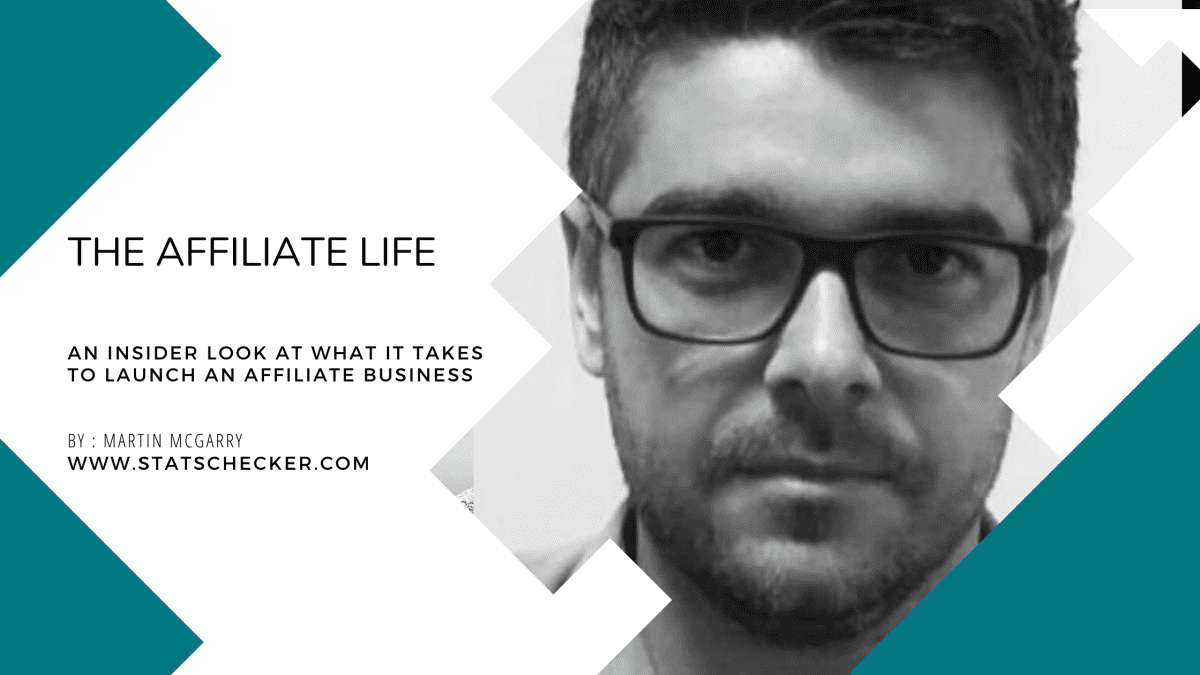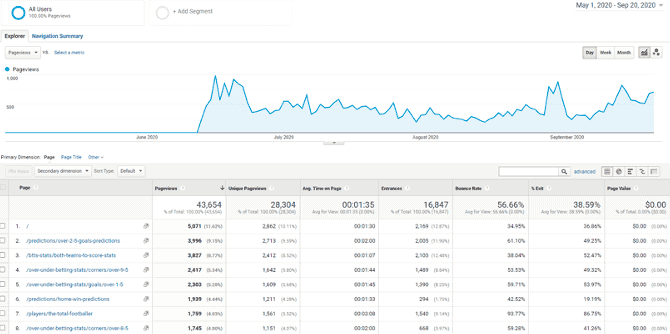The Affiliate Life: Starting out – Part II

Welcome to chapter 3, in this 12-month chronicle of The Affiliate Life: The Story of Starting an iGaming Affiliate Business.
Now is a good time to let you in on where I’m at on a personal level.
I’m not waking up at 5am hustling, nor am I going to bed at 1 am exhausted from the deluge of work carried out on my route to success. I’m not a sharp-witted entrepreneur with an amazing plan. I’m a fraud, a chancer and I don’t deserve this. I am beaten down by the suffocation of the continuing restrictions related to COVID-19. I am feeling exhausted by the overwhelming intensity of this global crisis and, truth be told, I’m struggling.
It has been a tough month
the staggered beginning to the football season wreaked havoc with my automated data collection. So, I have had traffic coming to an empty website. I deal in football league stats and so far, there are none! I’ve got a pipeline of development ideas, but my fear is crippling my vision. Sometimes I sit and stare, overwhelmed by potential and underwhelmed by my lack of resources. I hear the voices of previous advisors, conflicting and contradicting each other as they offer their 5 minutes of mentorship. “Get an investor, don’t give up your equity, get a business loan”.
Naturally, I’m not quitting. But there are days when I want to hit that delete button and forget I ever set out on this affiliate venture.
The data also tells this story…
Before we pick up part two of last month’s instalment, here’s some data I’d like to share:

Since this version of the site went live around June 2020, I’ve started to attract and grow traffic. I average around 600 page views per day when there’s a fair amount of football and sometimes, Google will present my site in a featured snippet. This accounts for some of the abnormal spikes. This SEO growth in such a short space of time is evidence that Google is accepting my site as a service provider. And gradually, they’re improving my site’s positions over time.
Lessons learned
I put out a piece of content last month about total football, profiling the most complete outfield player of the 2019/20 season. This was alongside an explanation of total football written by Stephen Tudor, who is a great football writer.
No surprise here: Lionel Messi came out on top of my list. And it ran around the time he wanted to leave Barcelona. I picked up a couple of backlinks, got a share from Millwall player Jed Wallace on a tweet and I put a £100 into boosting it on Twitter. All-in-all, it was a toe dipped into prospecting for future PR. It was a small effort, that returned very well in terms of traffic and coverage. With minimal efforts other than posting out to a few journalists, and making the thing in the first place, it was a success. Moreover, it was a signal that I can attract coverage on this site. I know that anyway, though. Football is a goldmine of news stories, but I’m trying to merge it with a gambling-based service.
A purposeful site design
For the eagle-eyed reader and, you might notice a lack of banners. The site isn’t monetised at all right now, and there’s a good reason for that. I often find the most unattractive thing about a gambling affiliate site, is that it’s a gambling affiliate site. So I have this crazy idea that I’m going to build up my SEO and traffic first. Once I’m happy with those, I will load up the CTA blaster and get some ads on my site!
I’m not far off that. But first, I wanted to get some momentum. I’ll walk you through how this turns out in the coming months.
Back to the 10 Start up tips…
If you missed my last instalment, I profiled how I was going to approach starting my affiliate business. In that, I covered points 1-5.
- Identify the area you wish to work in. What can I do; what am I passionate about?
- Speculate on the product offering. What am I selling; what could I sell?
- Consider my appearance in my sector (both name and branding).
- Create a business plan.
- Choose a model which will make this venture profitable.
I’m sharing more about points 6-10 of that process.
- Research, customer funnels, competitors, regulations and risks.
- Select your tools.
- Where will you operate from? Can this change?
- Imagine success. What does it look like, will you build a team and what skills do you need?
- Launch!
STEP 6: Do your research
Research, customer funnels, competitors, regulations, risks. You’ve got to know what you’re up against. Having been in this industry for a long while now, I know who I’m against. I’ve picked SEO as my core channel (for now). That means I’m competing against anyone who can hold real estate on my search queries; not only affiliates and operators.
We know the state of compliance in the sector is well-covered. I’d be stupid to ignore that and am aware that regulation might come into play at some point. I have thus chosen to remain authentic and focus on attracting quality organic traffic.
STEP 7: Select your tools
When we do this, it’s often reactionary. We have a need and find a tool or service provider to fulfil that. This step helps to prospect budgets and can shape various important decisions. These include the website you may build, whether you’ll choose free CMS and so on.
In my case, I also need to think about where I can get my football data. For example, do I want to take a chance on a cheaper provider and hope that my service can be optimised to compensate for any poor performance?
You should consider these decisions early on. Even if you can’t afford the tool you want now, you can aspire to hit that goal further down the line. I would love to work with data providers like Opta, The Racing Post and Timeform… but these are all way out of my price range right now. So, I’m looking for cheaper tools and providers – which is part of my risk assessment.
STEP 8: Check your geo’s and target accordingly
Where will you operate from? Can this change? This is a matter of resources. Given our current climate, the requirements of the ‘New Normal’ may influence this decision. I run my business from my home and for the foreseeable future, that’s how things will stay. Even if I build a team, we can be grown-ups when it comes to work/life balance. After all, we are in a dynamic and flexible world.
One day, I would love an office and team people who are proud to work for my company. But for now, I am at home like everybody else.
STEP 9: Envisage your business proposition and direction
Imagine success. What does it look like; will you build a team; what skills do you need?Visualisation is one of the most important techniques when looking at routes to success. Every day, you need to wake up and imagine the best version of yourself.
Once you are familiar with the improved version of yourself, you begin to accept that wanting that is realistic. On the flip side, surrounding yourself with negative self-images is all you’ll know.
Imagining success alone is enough to place ambition into your subconscious mind. Your inner critic is often the one who needs the most convincing that you can do it. I want to build one of the best sports betting affiliate sites in the world, period. I know that I’m a long way off right now. But it’s still an open market, which I can infiltrate!
There are only 3-4 big players in this sector. So, anybody willing to build real value and great customer service can achieve a top-five spot. Problem-solving drives customer service. Most problems come through Google, so the big winners are those that can dominate either paid or organic searches. If you can imagine it, you probably can achieve it. The million-dollar question is how you get there.
STEP 10: Plan your launch
In the words of a famous mentor of mine, JFDI – Just F@@@@G Do It! I will likely look back at my current iteration as a monstrosity of a website. Try not to aim for the finished product from the get-go. Instead, launch, improve and learn from your errors.
That’s all till next month…






